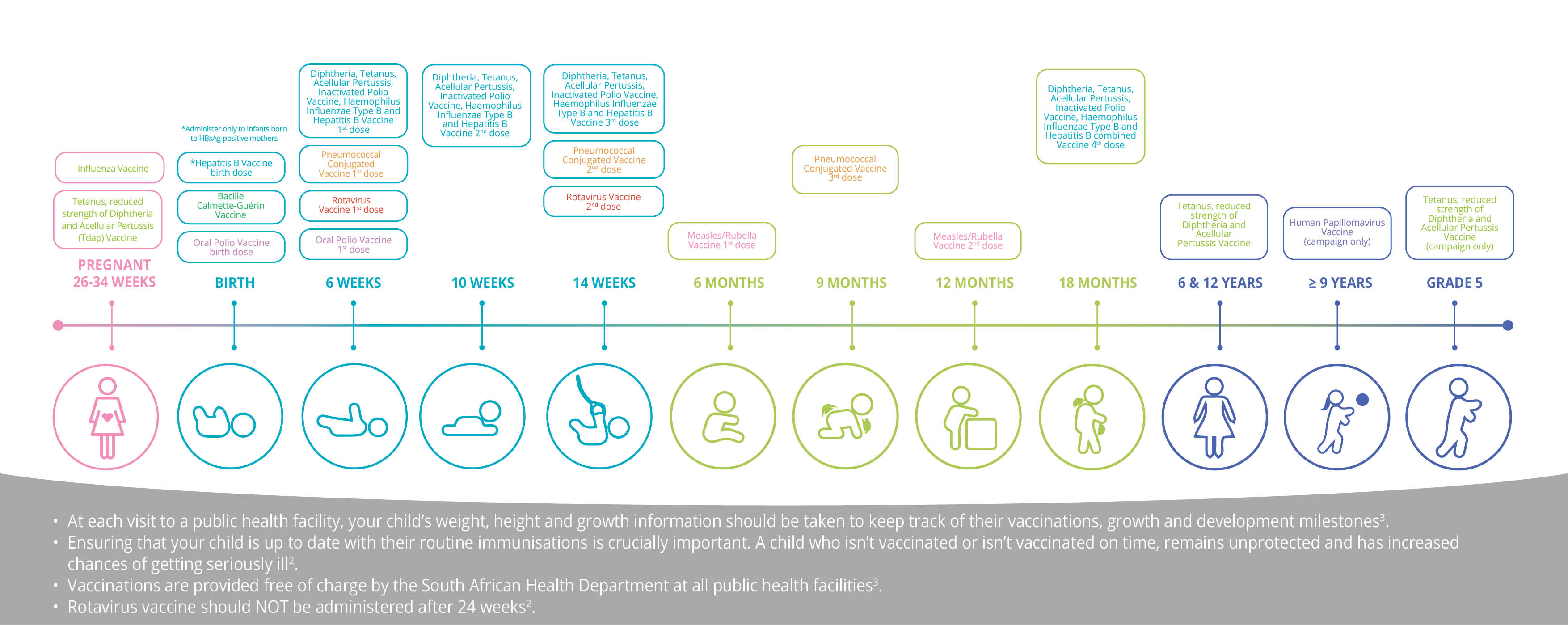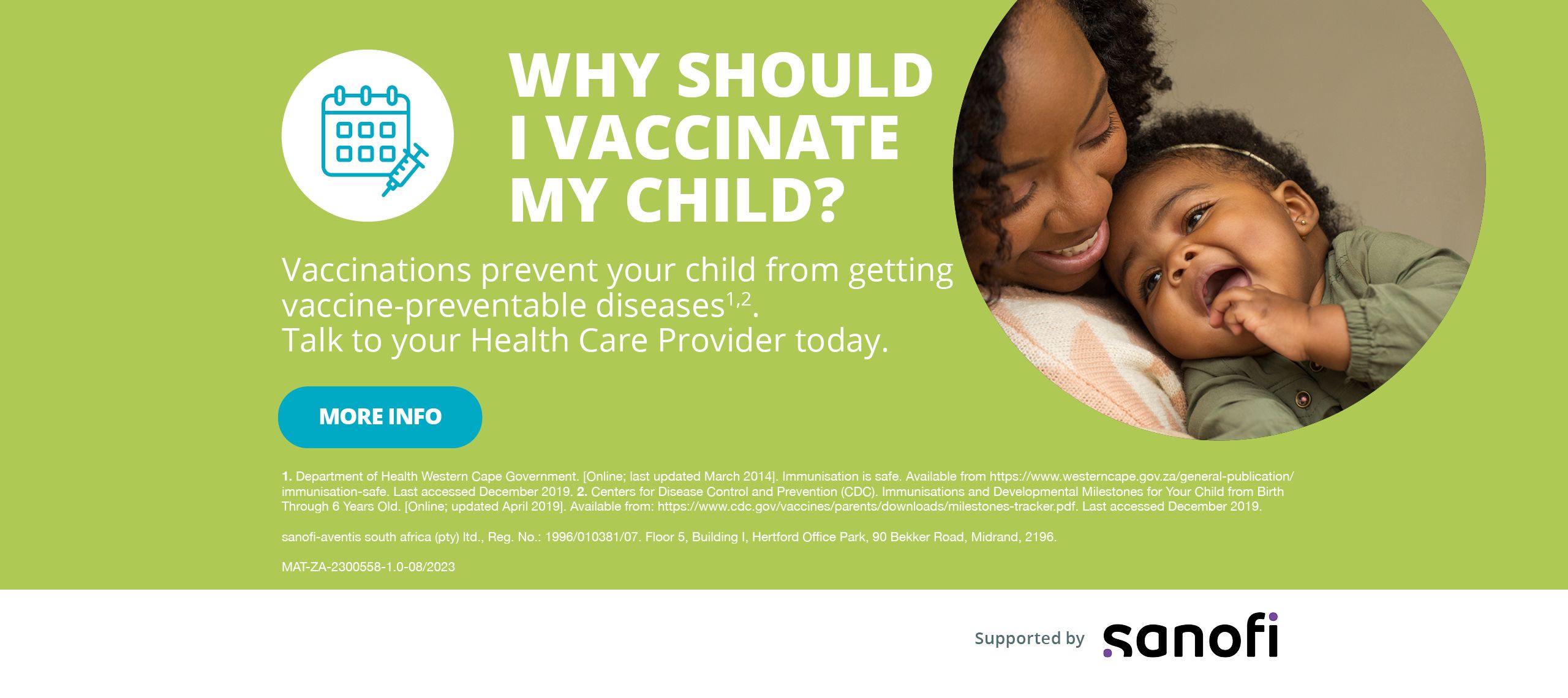Are your child’s vaccinations up to date?
Ensure you track your child’s vaccinations, growth and development milestones with ease, from pregnancy to adolescence.

With our world in constant change, growth and evolution, diseases are too. You can offer some protection to your child even before birth, by getting the recommended vaccines, which could provide them some level of immunity against certain life-threatening diseases1-4.
After birth, you can continue to help safeguard them from the harmful effects of vaccine- preventable diseases like tuberculosis, whooping cough, and others by ensuring they are on track with the recommended vaccines1-4.
To help you and your growing child stay prepared and on track to know when you both need each routine vaccination, Sanofi has created a timeline based on the Department of Health's schedule, to support both new and experienced parents with navigating the vaccination journey3.


PROTECT YOUR CHILD.3 PROTECT YOUR COMMUNITY.3
Ask your Health Care Professional (e.g. nurse) for advice on the vaccinations your child should get.
Pregnant Women
Vaccinating against tetanus, diphtheria, and pertussis between 26 and 34 weeks of your pregnancy can help protect you and your baby until his or her routine vaccinations start3,4. Speak to your health care practitioner about which vaccines to take during your pregnancy for protection against the flu3.
At birth
At birth, vaccinations are available to protect your child against TB and polio. If you had tested positive for hepatitis B virus infection during pregnancy, you baby will also receive the vaccine against hepatitis B3.
At 6 weeks
Your 6-week-old infant is eligible to receive routine vaccinations for hepatitis B, diphtheria, tetanus, pertussis, polio, Haemophilus influenzae type b, pneumococcal and rotavirus3.
At 10 weeks
At 10 weeks, your baby can receive their routine vaccinations for hepatitis B, diphtheria, tetanus, pertussis, polio and Haemophilus influenzae type b3.
At 14 weeks
Similarly, at the 14-week mark, your baby can receive their routine vaccinations for hepatitis B, diphtheria, tetanus, pertussis, polio, Haemophilus influenzae type b, pneumococcal disease and rotavirus3.
At 6 months
At the 6-month mark, your baby is due to receive their measles and rubella vaccination3.
At 9 months
At 9 months, your baby is due for a follow-up to receive a third pneumococcal vaccination3.
At 12 months (1 year)
When your baby hits the 12-month milestone, they are due for their follow-up measles and rubella vaccination3.
At 18 months
At 18 months, your toddler is due for a round of routine vaccinations for hepatitis B, diphtheria, tetanus, pertussis, polio and Haemophilus influenzae type b3.
At 6 years
Fast forward to age 6, and your school-going child can child can be vaccinated to help protect against tetanus, diphtheria and pertussis3.
At 9 years
From age 9, young girls are eligible for the vaccination against the Human papillomavirus virus3.
Grade 5
Both girls and boys in grade 5 may be vaccinated against diphtheria, tetanus and pertussis, as part of the school-based campaign programme3.
At 12 years
To wrap up the childhood vaccinations, by age 12, your tween can receive their follow-up vaccination against diphtheria, tetanus and pertussis3.
So, what exactly are vaccines and how do they work?
Two key things set vaccines apart from other medicines.
1The first differentiator is the way they are designed – they are created to prevent disease, as opposed to treating it or the symptoms5. This is done by ‘priming’ a person’s immune system to recognise specific disease-causing bacteria, or viruses5. The body has natural ways to prevent the entry of pathogens and harmful bacteria – e.g., the skin, mucus and cilia (microscopic hairs that filter debris in your airways and lungs). However, since germs are all around us, we are constantly at risk and susceptible to contracting diseases – some of which may lead to death6.
Our immune system helps our bodies process pathogens and create antibodies to help fight off disease and illness by ‘remembering’ the pathogens, in order to help defend the body against contracting the disease and illness again in future6.
Vaccines contain weakened or inactivated parts of a particular organism (antigen), which triggers an immune response in your body. Some newer vaccines come prepared with a sort of ‘blueprint’ for producing antigens – aiding the immune system to prepare for defence against disease6. Vaccines allow the immune system to develop "memory cells", which equip the body with the ability to rapidly fight a disease-causing organism when next it is exposed to it6.
2The second way vaccines are set apart is that they are commonly biological products, rather than chemical medicines5,7. This means that they are derived from living cells of bacteria, yeast, plants or animals7.
Why are vaccines important?
Given the nature and purpose of vaccines being created as a means of prevention1,2, they also help manage and contain the spread of diseases – saving around 3.5 – 5 million lives each year8.
Routine childhood vaccinations help us develop early immunisation against certain serious infectious diseases. This has led to some of these diseases becoming less common, and even eliminated, in areas with high vaccination levels1.
Read more how to prevent and protect with Sanofi:
References:
- Department of Health (DoH) Western Cape Government. For You. Immunisation. Available from: https://www.westerncape.gov.za/service/immunisation. Accessed April 2024.
- Centers for Disease Control and Prevention (CDC). Vaccines by Age. Available from: https://www.cdc.gov/vaccines/parents/by-age/index.html. Accessed April 2024.
- Expanded Programme on Immunization – EPI (SA) Revised Immunisation Schedule from January 2024.
- GOV.UK. Whooping cough vaccination in pregnancy guide. Available from: https://www.gov.uk/government/publications/resources-to-support-whooping-cough-vaccination/whooping-cough-vaccination-in-pregnancy-guide. Accessed April 2024.
- Joi P. Vaccines Work. Vaccines Explained. Available from: https://www.gavi.org/vaccineswork/vaccines-explained. Accessed April 2024.
- World Health Organization. How do vaccines work? Available from: https://www.who.int/news-room/feature-stories/detail/how-do-vaccines-work. Accessed April 2024.
- World Health Organization. Biologicals. Available from: https://www.who.int/health- topics/biologicals#tab=tab_1. Accessed April 2024.
- World Health Organisation. Vaccines and immunization. Available from: https://www.who.int/health-topics/vaccines-and-immunization#tab=tab_1. Accessed April 2024.
sanofi-aventis south africa (pty) ltd., Reg. No.: 1996/010381/07, Floor 5, Building I, Hertford Office Park, 90 Bekker Road, Midrand, 2196.
MAT-ZA-2301095-1.0 - 05/2024


